We are experiencing digital transformation at epic speed. COVID-19 has accelerated secular trends in the ways we work and live, jumpstarting durable new habits that will persist well past the pandemic.
Throughout 2020, as we’ve navigated the equivalent of a year of digital transformation every month, it’s IT pros who’ve led the way. When COVID-19 caused a sudden shift to remote work, IT pros brought entire organizations online—sometimes over a single weekend. They trained individuals and teams on essential new tools, quickly deployed custom apps, and vigilantly protected organizations from increasingly complex security threats. Now, as business leaders look to build resilient organizations and find new opportunities for expansion, they’re looking to IT pros for sustainable solutions to support them for the long haul.
We want to help. At Microsoft, it’s our mission to empower every person and every organization on the planet to achieve more. Today at Microsoft Ignite, we’re announcing scores of new features and capabilities that aim to do just that. But in this age of accelerated transformation, helping our customers achieve more also requires a broader view. So we’ve committed to becoming the world’s best students on the future of work, closely studying our own telemetry, and working closely with customers and researchers across every field, to understand our challenging new reality. This unique vantage point has shaped our understanding of where leaders and organizations need to focus today and in the future, and guided our innovation investments to build tools to support them.
As we kick off Microsoft Ignite 2020, here are seven keys to success for every IT and business leader to empower people for the new world of work—plus innovation in each area to deliver human ingenuity at scale.
1. Reimagine teamwork, culture, and social capital–digitally.
We’re reimagining meetings and workspaces to unlock new forms of collaboration, help people and teams stay connected and engaged, and ensure fluid communication across organizations.
Better meetings for everyone
Microsoft Teams offers an end-to-end meeting solution that scales to support your meeting, calling, and large-scale event needs. Announced this summer, Together mode is a new meeting experience in Teams that helps participants feel closer together even when they are apart by placing them in a shared background. This makes meetings more engaging by showing participants’ faces and body language, making it easier to pick up on the non-verbal cues that are so important to human interaction. Today, we’re announcing new Together mode scenes, including auditoriums, conference rooms, and a coffee shop—all available later this year. Presenters will be able to select a scene from the gallery as the default for all meeting attendees. We’re also introducing the use of machine learning in Together mode to automatically scale and center meeting participants in their virtual seats, regardless of how close or far they are from their camera, creating a more realistic visual experience.
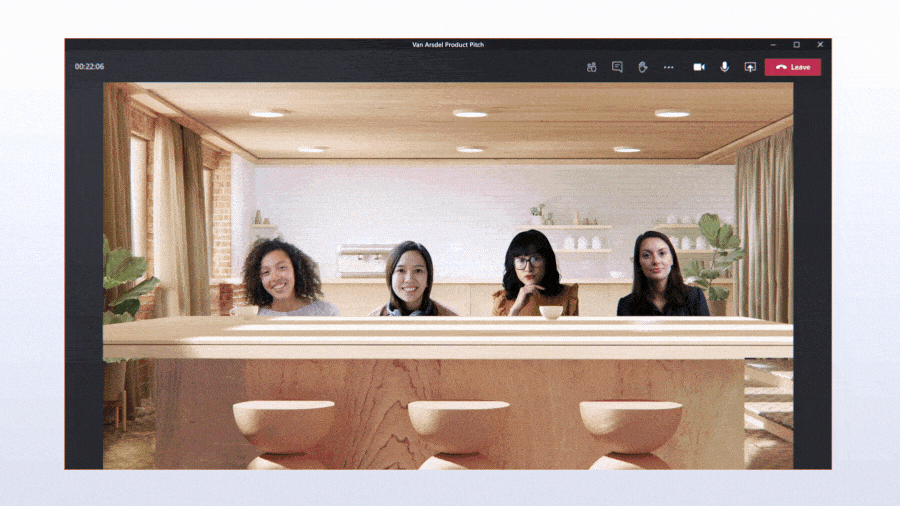
In July, we announced new ways for meeting participants to control what they see in Teams with Dynamic view. Today, we’re announcing custom layouts, coming later this year, that will allow presenters to customize how content shows up for participants during the meeting. For example, when a presenter is showing a PowerPoint slide, participants will be able to see the presenter’s video feed transposed onto the foreground of the slide they’re showing.
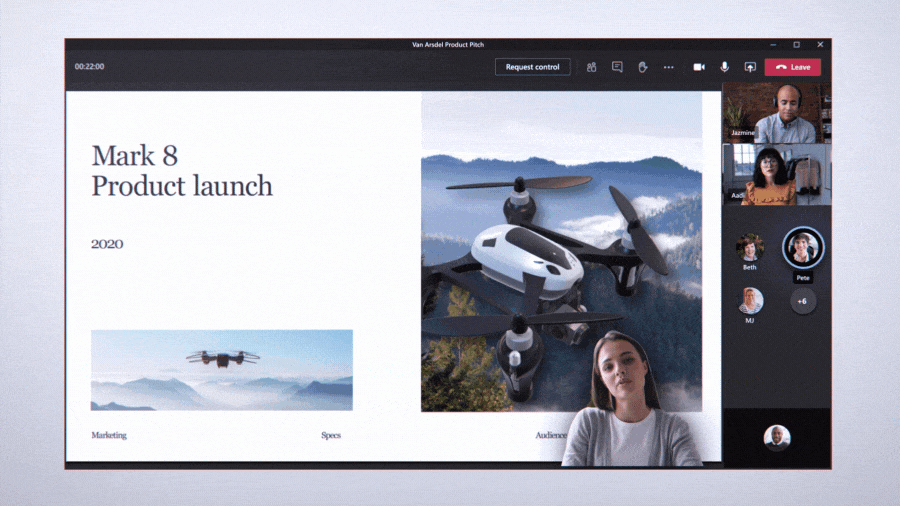
We’re also excited to announce that Breakout rooms, one of the most requested Teams features, will be available next month. Meeting organizers will be able to split up participants into smaller groups to facilitate brainstorming sessions or workgroup discussions. Presenters can then hop between breakout rooms, make announcements to all breakout rooms, and close the rooms to return everyone to the main meeting.

More than 20 partners including HireVue, ServiceNow, Range, Buncee, and PagerDuty are using new Teams meeting extensions, which will move to general availability in October, to integrate their apps and enable custom meeting experiences in Teams. Meeting organizers can access apps from either AppSource or the Teams store and add them as they schedule the meeting.
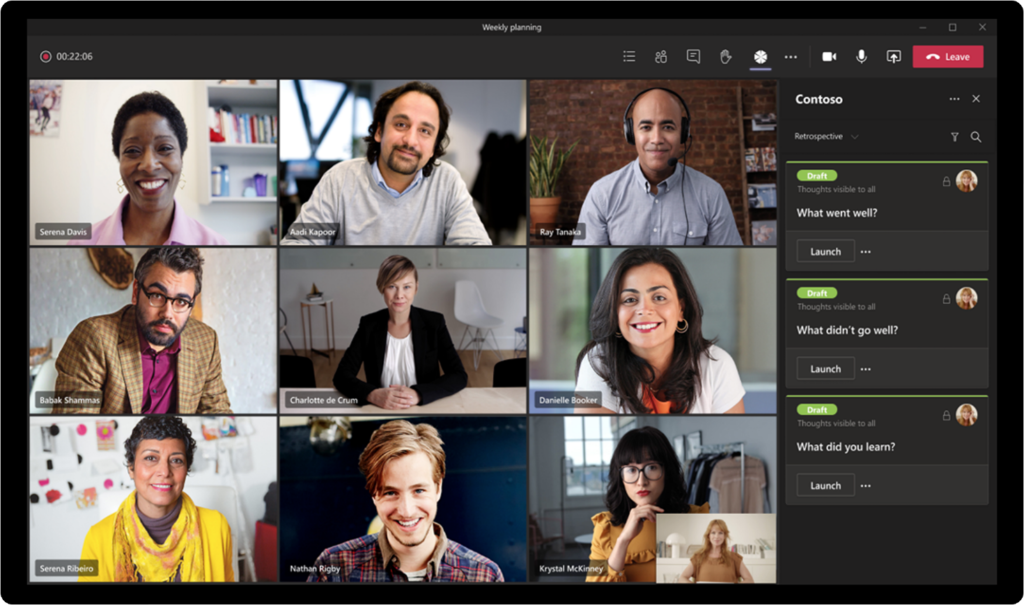
After a meeting in Teams, a recap with the meeting recording, transcript, chat, shared files, and more will be automatically created in Teams. Meeting recaps help move work forward for both meeting participants and for those who were unable to attend a meeting. The recap will also be available in your Outlook calendar by going to the meeting event. And soon, meeting recordings will be automatically stored—like other files are today—in Microsoft 365 so they can be shared, easily and compliantly, with external participants.
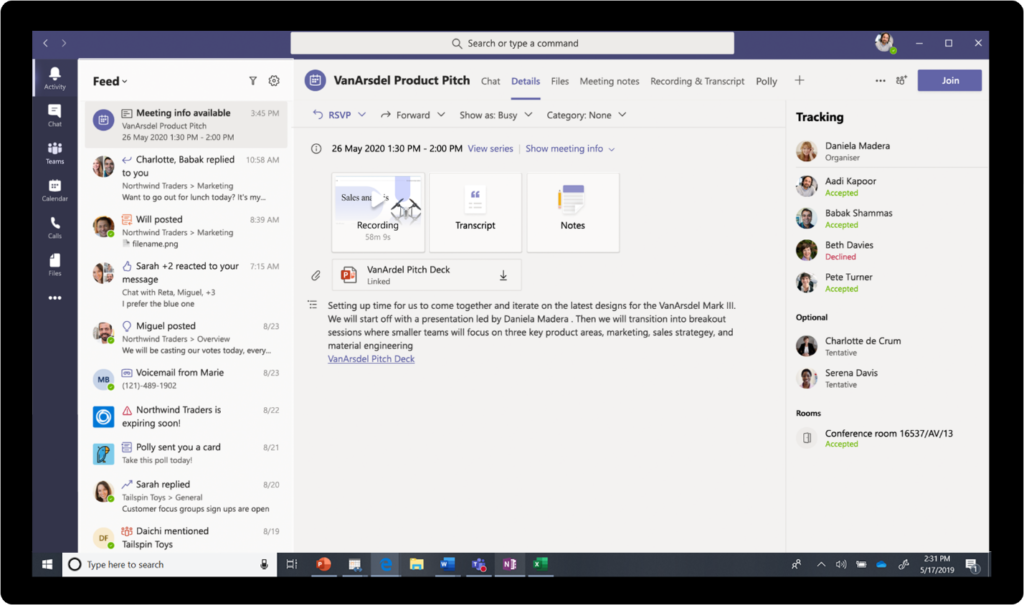
For customer presentations including webinars, we’re announcing Teams support for attendee registration with automated emails to make it easier to manage attendance and view a reporting dashboard after the meeting to help understand attendee engagement. Attendee reporting and scheduling APIs will also be available, so customers can bring this data into their CRM and marketing automation apps, and more.
A number of enhancements are coming later this year for the Calling experience within Microsoft Teams, including a streamlined view that shows contacts, voicemail, and calling history at once, making it easier to initiate or return a call with a single click.
Also, Teams meetings are growing to support up to 1,000 participants with the full meeting experience by the end of the year. For larger meetings and events that require additional control, Teams will soon seamlessly scale to support 20,000 participants in a view-only meeting experience that includes the ability to use live captions. These new capabilities will be available to customers with the new Advanced Communications plan. Learn more about these enhancements in the Microsoft Tech Community.
Tools for a connected employee experience
The new home site app brings the power of your SharePoint home site, along with the rest of your intranet, directly into Teams. This gives employees an easy gateway to their organization’s intranet, with customizable naming, branding, and multi-level navigation to teams, communities, and resources. Coming later this year, you’ll be able to customize the app name and icon to match your organization’s branding and pin it to the app bar in Teams for quick access to search and a personalized view of news and important sites.
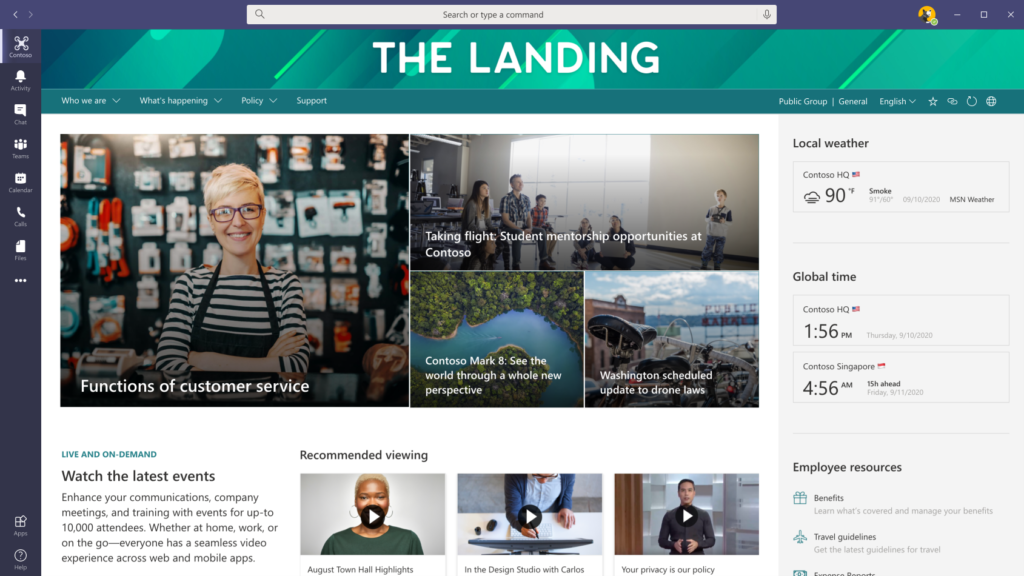
We’re also announcing a set of new tools for workplace communications that will enable organizations to boost the visibility of news and announcements, better connect employees to their leaders, and foster a tighter workplace community. Learn more about those on our Microsoft Tech Community blog.
Devices for the workspace of the future
To help create workspaces where people can collaborate effectively and safely both remotely and from the work site, we’re designing experiences where every attendee—remote or in-person—is a first-class participant. As organizations continue the transition back to the office, shared space devices like Microsoft Teams Rooms and Surface Hub will be critical tools in delivering the ultimate hybrid workplace experience. To help you get started, Microsoft, with support from specialized meeting room partners, can deploy two of your Teams Rooms at no additional charge (terms and conditions apply). Learn more at rooms.microsoft.com.
Today we are announcing Microsoft Teams panels, a new category of devices that can be mounted outside of a meeting space to notify participants of scheduling and occupancy and to assist with wayfinding around the office. Teams panels can also use information from other connected certified Teams devices, like cameras that support people counting, to show room capacity information and help everyone follow their organization’s safety guidelines for shared spaces. We are happy to announce our first Teams panel partners are Crestron and Yealink.
We’re also enabling additional ways to engage with in-room devices without touch. Later this year, Microsoft Teams Rooms devices will support new touchless meetings capabilities—like the Room remote app, Teams casting, and voice assistance with Microsoft Cortana.

Today, we’re also excited to announce that the Surface Hub 2S 85-inch model is available for pre-sale reservations for commercial customers in the US, with availability beginning in January 2021. Surface Hub harnesses the full power of Microsoft, including Microsoft 365, Teams, Windows, and more to create connections and unlock productivity for teams everywhere. We’re also announcing two new software capabilities for Surface Hub 2S. First, we’re bringing the full Windows 10 desktop experience to Surface Hub 2S, which gives people a truly personalized Windows experience on a brilliant large screen. Second, we’re releasing the Windows 10 Team 2020 Update for Surface Hub 2S, which improves the Teams meeting experience and introduces the new Microsoft Edge browser to Hub. For more details, check out this Surface blog post.
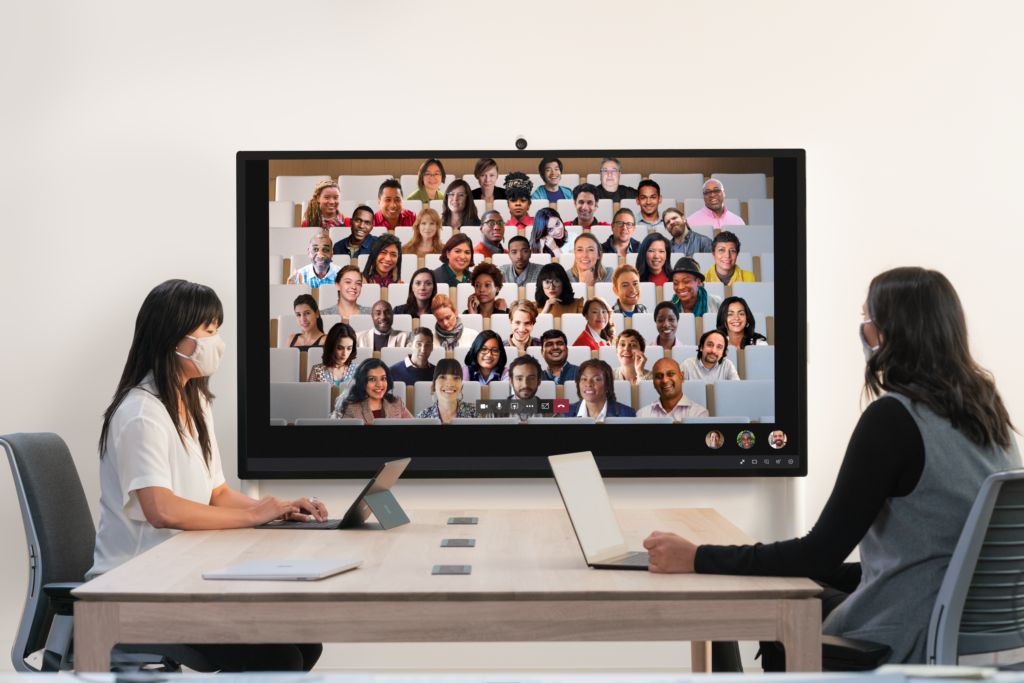
2. Prioritize wellbeing to help people focus and be their best.
As the in-office, nine-to-five workday gives way to fluid work models and flexible hours, we’re spending more time communicating with one another digitally, and often outside of traditional work hours. In Teams, for instance, we’re seeing the number of chats and meetings per person continue to grow, especially after hours. Meanwhile, workdays around the world are increasing in length. While it’s great to connect with our teammates, we all need reminders to take time to detach from work in order to preserve our wellbeing. Research from our latest Work Trend Index underscores just how important this is. In a global study, over 30% of Firstline and information workers said the pandemic has increased their sense of burnout at work. And one-third of remote workers said the lack of separation between work and life is negatively impacting their wellbeing. To help leaders prioritize wellbeing for every employee, we’re introducing experiences to help structure the day, make space for breaks, nurture relationships, and stay on top of tasks.
Wellbeing experiences in Teams
We may not miss that hour of traffic bookending our days, but studies from Microsoft Research shows that commutes can serve as meaningful transitions at the beginning and end of the workday—and that the reflection we do during that time can increase productivity by 12-15%. Available in the first half of 2021, new features in Teams will make it seamless to structure your day by scheduling a virtual commute that helps you have a productive start in the morning and mindfully disconnect in the evening. Our global study also found that 70% of people think meditation could help relieve their work-related stress. The science backs this up. Studies show meditation can reduce stress and burnout and improve your ability to react to feedback. So today, we’re excited to share that we have partnered with Headspace to bring a curated set of mindfulness experiences and science-backed meditations into the flow of work in Microsoft Teams. Whether you’re a remote worker looking to find focus before a big presentation or a Firstline Worker hoping to de-stress after a long workday, this experience makes it easier to find time to relax and recover.
A new stay connected experience in Teams helps individuals strengthen relationships with their colleagues by making it easy to praise top collaborators for key achievements and to schedule 1:1s to catch up. It also helps you stay on top of your commitments by intelligently surfacing suggested tasks and emails from Outlook—plus @mentions in Teams—that might require follow up.
Near the start of the day, individuals will also receive a daily Briefing email from Cortana—including key personal productivity insights and suggested tasks for that day—right in their Outlook inboxes. This feature will become generally available beginning in September.
Manager and leader insights in Teams
Managers carry the life preservers for their teams in periods of disruption, helping them prioritize and protect their time while staying connected. Beginning in October, we are bringing Workplace Analytics into Teams to give managers line of sight into teamwork norms like after-hours collaboration, focus time, meeting effectiveness, and cross-company connections. These will then be compared to averages among similar teams to provide managers with actionable insights.
Currently, Workplace Analytics offers manager-initiated change programs to bring the team together around an action plan for improving health and effectiveness. Suggestions remind individuals to unplug at the end of the day, reclaim time to focus, and reduce meeting overload. Weekly summaries allow the team to monitor progress and celebrate successes. In 2021, we will integrate these features into Teams as well.
As organizations face uncertainty and change, company leaders need visibility into how work is evolving and how changes are affecting the people whose creativity and innovation will propel their business into the future. Powered by Workplace Analytics, new insights in Teams allow leaders to ask questions like “Are employees at risk for burnout? Are people maintaining strong internal connections? Are relationships with customers being maintained?” Operating like a health monitor for organizational resilience, this feature helps leaders track indicators of employee wellbeing, respond to irregular rhythms with research-backed best practices, and measure the impact of change over time.
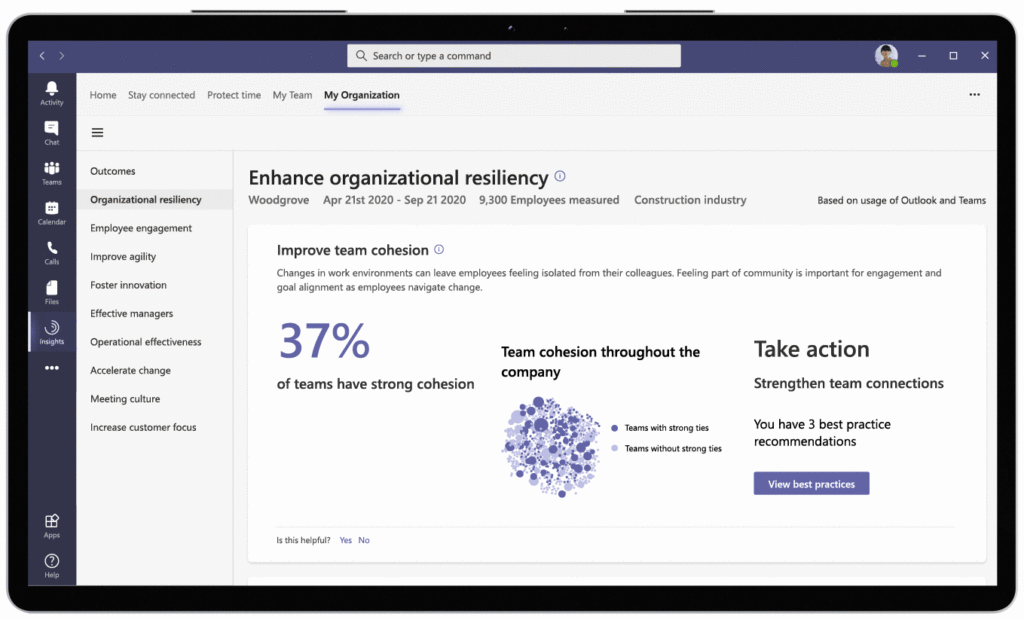
Finally, we’re refreshing the business continuity report, part of the Microsoft Productivity Score, to help customers measure how the move to remote work has affected collaboration norms for their organizations.
3. Create a trusted, secure, modern experience for every employee.
As flexible hours and hybrid work models become the norm, providing a secure modern experience for every employee has never been more important. We’re introducing new features and capabilities for IT pros to help empower everyone to work securely from anywhere. We’ve included highlights below, but please check out my colleague Brad Anderson’s Microsoft 365 blog for a deep dive.
New features in Microsoft Endpoint Manager
Microsoft Endpoint Manager is the command center that allows IT pros to make remote and hybrid work possible for individuals and teams across their organizations. Today, we’re announcing the public preview of several features in Endpoint Manager designed to improve end-user experiences and simplify IT practices. Integrated into Endpoint Manager, Microsoft Tunnel is a remote access solution that enables iOS and Android devices to connect on-premises apps and resources from virtually anywhere. Endpoint Manager also now supports management of virtual endpoints, so you can manage your Windows Virtual Desktop endpoints, or third-party VDI solutions, within the same console as your physical PCs. We are now also providing a first-class management experience on macOS to meet the productivity needs most important for our Mac admins. New capabilities include the ability to deploy scripts to devices, new enrollment experiences with single sign-on (SSO) across apps, and new managed app lifecycle features from Apple. We’re also announcing support for Shared iPad for Business. This allows IT pros to deploy shared iPads to users and allow them to log in with their Microsoft Azure Active Directory work accounts into separate partitions of the device.

New investments in security, compliance, and identity
Today we are also announcing that we are unifying our solutions across Microsoft 365 security and Azure security to deliver the most comprehensive extended detection and response (XDR) on the market. Microsoft Defender, now inclusive of Microsoft 365 Defender and Azure Defender, prevents, detects, and responds to threats across identities, endpoints, applications, email, infrastructure, and cloud platforms.
And to help organizations around the world as they face the need to comply with an increased volume and frequency of industry and regional regulations, we are announcing the new Compliance Manager, which provides a library of more than 150 out-of-the-box and scalable assessments.
To help you to protect identities, apps, and services across your entire environment, both in and outside of Microsoft, we are also announcing new Azure Active Directory Application Proxy capabilities and partner integrations, as well as new Microsoft 365 connectors and Microsoft Graph APIs.
These are just a taste of the many security, compliance, and identity innovations we’re announcing at Ignite today. For more about our new investments in security, compliance, and identity, please check out my colleague Vasu Jakkal’s blog.
New employee and technology experiences in Productivity Score
Also integrated into Endpoint Manager, the previously announced Endpoint Analytics in Productivity Score will be generally available by the end of October to help organizations understand and empower great work with powerful technology. Productivity Score focuses on two areas, the employee experience, and the technology experience, offering visibility into how your organization works, insights to identify where you can make improvements, and actions you can take to update skills and systems so that everyone can do their best work.
Productivity Score will also introduce three new categories. Two new employee experience categories focus on meetings and teamwork to help leaders understand best practices and technologies that help ensure inclusive, consistent, and effective ways for people to work together. Meanwhile, a new technology experience category, Microsoft 365 Apps health, provides insights into performance and currency, keeping critical apps up to date, secure, and able to support employee workflows. To learn more about these updates check out the dedicated Productivity Score blog post.
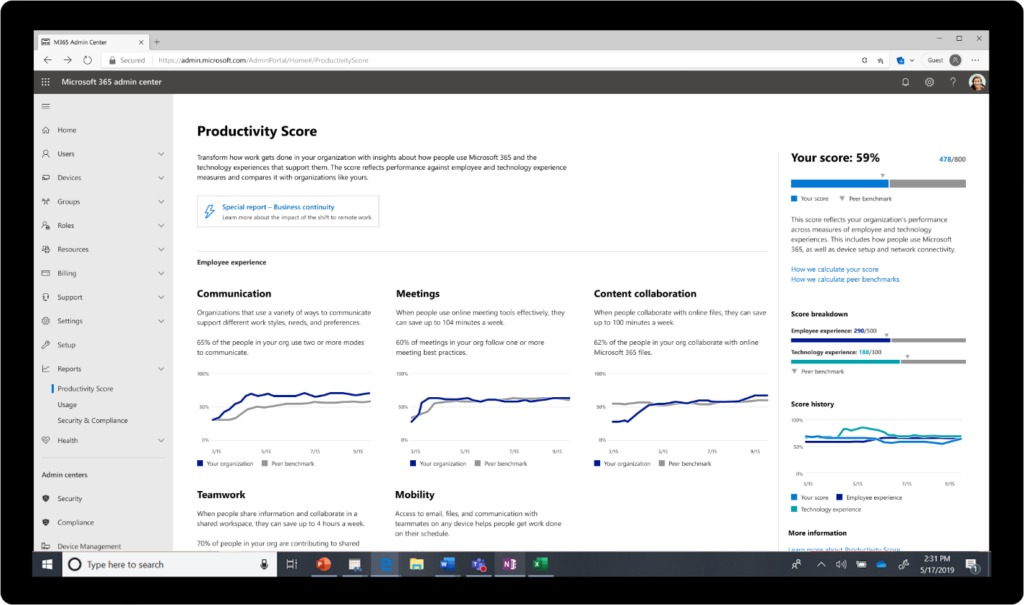
A new Outlook experience for Mac
We’re also pleased to announce the new Outlook for Mac. Built on Microsoft sync technology, it brings updates across the Mail, Search, Calendar, and People experiences that are designed for simplicity, reliability, and customization. The updated experience is carefully crafted and specifically designed with the power of Microsoft Services to provide suggestions and insights that are relevant to you and enable you to customize the experience. Read all of the details on our Outlook blog.
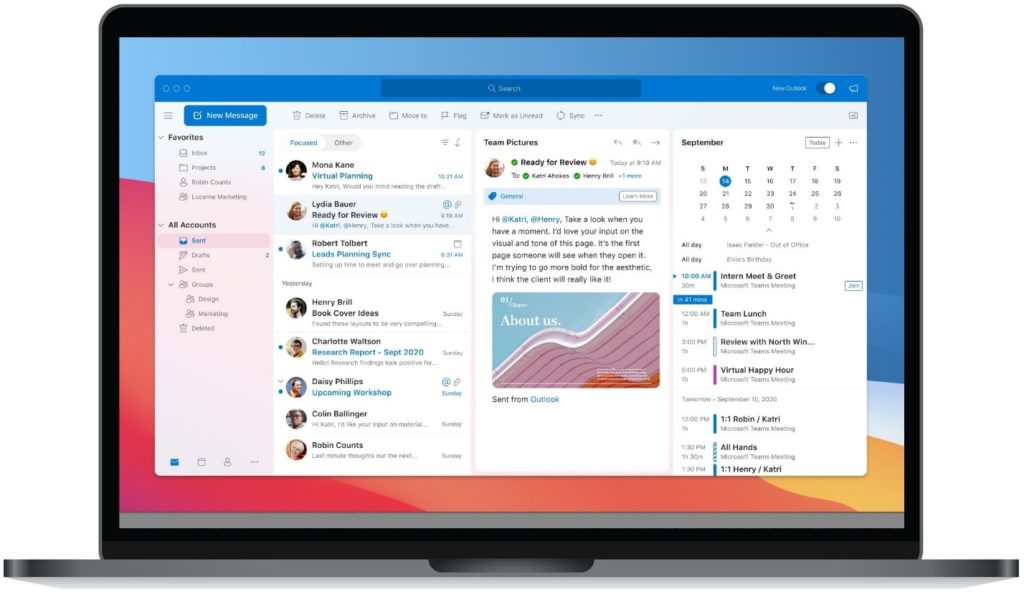
New Microsoft Office management and servicing capabilities
To help customers get the most out of their Microsoft 365 investment, we are announcing a wave of new Office management and servicing capabilities. These include a predictable and reliable enterprise-level servicing model designed to minimize interruption and to optimize network utilization. IT admins will get additional flexibility through capabilities like push-button rollback and “snooze updates until next release.” We’re also introducing new cloud-based controls and insights—including inventories of apps and add-ins, insights into channel mix, security patch compliance, and detailed controls. Tools to manage regressions and apply policies will further help IT to boost performance, reliability, and security without compromising controls or adding extra costs. Finally, new Office app health and remediation capabilities will help free IT pros to focus less on troubleshooting and more on delivering strategic value to their organizations.
New innovations for Windows Developers
We are doubling down on Windows developer innovation at Ignite this year with the latest version of React Native for Windows, new MSIX features, updated Windows Runtime components, new Windows SDK packages, and more. All the developer enhancements are designed to streamline and simplify opportunities for Windows developers and amplify what is possible on the Windows platform. Many of these new features and packages are available today or later this year. To learn more, visit the Windows Developer Blog.
Microsoft Edge on Linux
With the new Microsoft Edge, we want to free customers to use the browser across all of their devices. In addition to Windows 10, the new Microsoft Edge is already available on Windows 7, Windows 8, macOS, iOS, and Android, and today we’re announcing that the preview of Microsoft Edge on Linux is coming in October. Customers will be able to download the Microsoft Edge Dev channel for Linux from the Insiders website or from the native package manager. To learn more about everything new with Microsoft Edge, and its powerful anti-phishing tools, visit the Ignite edition of the new Web Experiences Blog.
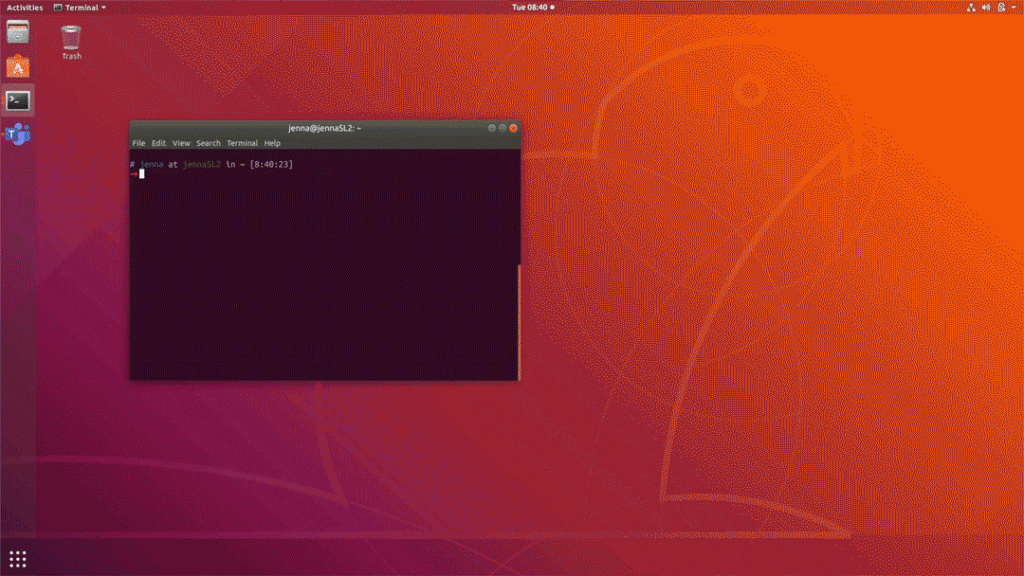
4. Unlock the data, knowledge, and expertise of the entire organization.
Powered by the Microsoft Graph, our knowledge experiences allow you to capture and redeploy all the information in your organization to benefit individuals and teams.
Transforming content into knowledge
Last year we announced Project Cortex, a Microsoft 365-initiative to surface insights and expertise in the apps you use every day using advanced artificial intelligence (AI). Based on customer feedback provided during private preview, we will be making these AI-powered capabilities available to customers as a set of unique innovations.
The first product we will deliver is SharePoint Syntex, which uses advanced AI and machine teaching to amplify human expertise, automate content processing, and transform content into knowledge. SharePoint Syntex lets you teach AI to read a document and extract information as you would with no-code AI models. Next it uses your models to automatically process content, then extracts information and applies metadata. With rich metadata, you can find and work with content more easily and automatically apply sensitivity and retention labels to manage compliance and streamline processes—for instance, flagging files that deserve attention. SharePoint Syntex will be available to purchase for Microsoft 365 commercial customers on October 1. We’ll be releasing new services later this year that organize information into topics and deliver knowledge to enable a rich employee experience throughout Microsoft 365. Learn more.
A new vision for Microsoft Stream
We’re excited to share a new vision for Microsoft Stream—the intelligent video app in Microsoft 365. We’re rebuilding Stream to integrate seamlessly with applications across the suite, so you can create, share, and discover video as easily as an Office document. Customers who want to create future-proof video experiences in Microsoft 365 can start today with SharePoint and Graph File APIs. For customers using classic Stream, we will support your transition to the new Stream over the coming months, with a phased introduction of new features in Microsoft 365, migration tools, and guidance.
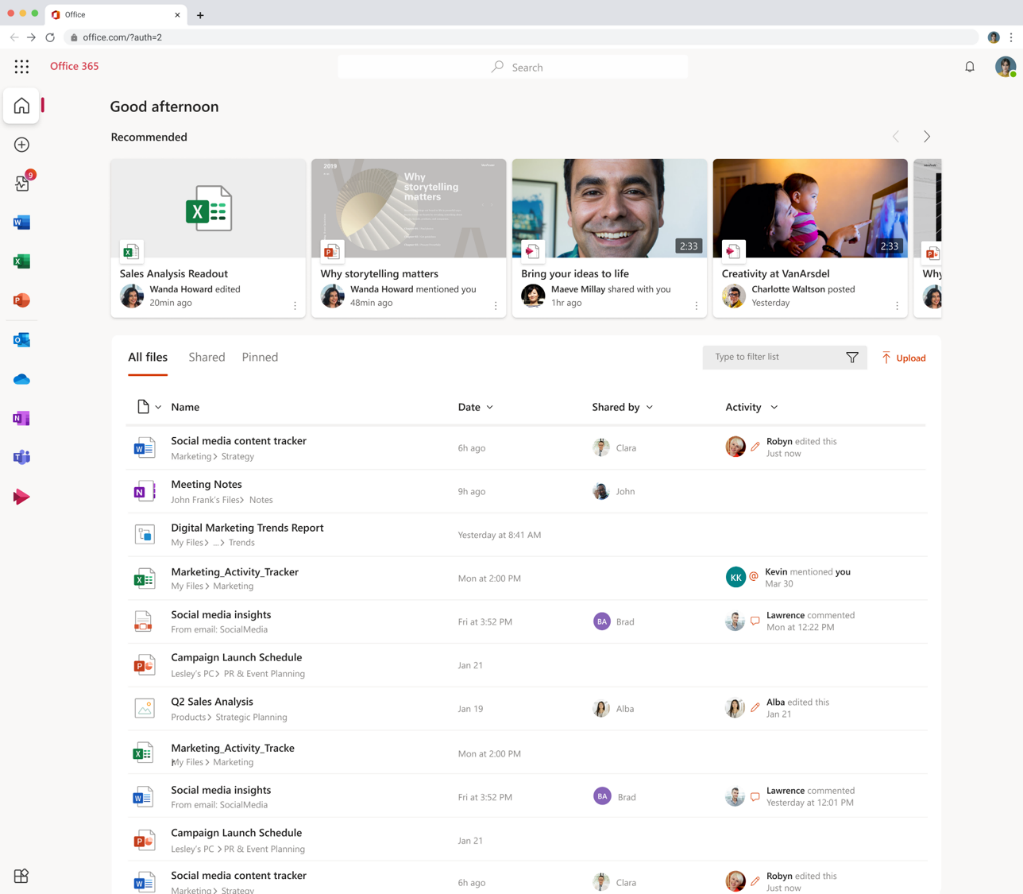
New innovation in Microsoft Search
We’re also introducing new innovations in Microsoft Search, including Microsoft Graph connectors, to include a new connector from Microsoft for Salesforce. Microsoft Graph connectors let you search across not only Microsoft 365 but dozens of external services as well, in addition to over 100 unique connectors from our partners. Read more in our MTC blog.
5. Automate process and workflows to increase discontinuous innovation.
AI and automation streamline workflows and free people up from rote tasks, giving them back time, focus, and energy for the creative and innovative work that only humans can do.
Business process transformation with Teams plus Power Platform
Users will soon have even more intuitive and powerful low-code ways to build the solutions they need to run their business processes in Teams. We’re excited to announce the general availability of the embedded Power Apps and Power Virtual Agents studios, powered by “Project Oakdale,” which give Teams users the ability to build, edit, and publish custom apps and chatbots—right in Teams. And building and deploying those custom bots is even easier with native authentication and simple bot publishing. A new Power Automate app in Teams makes it easier to automate workflows with easy-to-use templates and a simpler building experience. Microsoft Teams will also natively enable approval workflows, which can be customized using Power Automate, and we expect to integrate e-sign services such as Adobe Sign later this year. Lastly, the new Power BI app for Teams allows organizations to foster a data-driven culture with a central hub for data and reports, including curated recommended reports. These features will launch later this year.
6. Include everyone in digital transformation.
New industry solutions, along with experiences designed for Firstline Workers, help organizations enable digital transformation for all their employees.
Industry solutions in Teams
Ensuring that people have access to the right tools to do their jobs is pivotal in every industry, especially industries like government, financial services, and healthcare. It’s now even easier to tailor Teams for industry with templates, get virtual visit reminders and join via mobile, enable collaboration with Lists, and much more.
For example, many healthcare organizations have ramped up their telehealth offerings to enable remote medical visits and support telehealth workflows with Teams. The new Microsoft Teams EHR connector, now in private preview, will allow clinicians to launch a virtual patient visit or consult with another provider from within their electronic health record (EHR) system. This will streamline the experience for doctors and patients, helping them provide high-quality care. Epic will be the first EHR system to integrate with Teams in this way, and Teams will be available in the Epic App Orchard later this year. This is one of the many new capabilities within Microsoft 365 and the new Microsoft Cloud for Healthcare.
To further reduce the administrative burden on clinicians, Nuance and Microsoft have partnered to integrate Nuance’s Dragon Ambient eXperience (DAX) with Teams. This integration adds Nuance and Microsoft’s AI investments to virtual visits by securely capturing and contextualizing physician-patient conversations, and automatically documenting the encounter from within Teams. The Nuance DAX and Teams integration is available in private preview.
New experiences for Firstline Workers
Today we are announcing the general availability of several exciting new capabilities for Firstline Workers. First, Teams Walkie Talkie for Android is a push-to-talk experience that enables clear, instant, and secure voice communication over the cloud. Firstline Workers can also collaborate hands-free with remote experts using the Teams app for RealWear head-mounted devices. Firstline managers can use shift schedule assistance to get alerts if conflicts occur when creating schedules or when approving schedule change requests. And lastly, customizable praise badges open the possibility to promote your company values in celebration of every success and foster greater camaraderie during a time of disconnect.
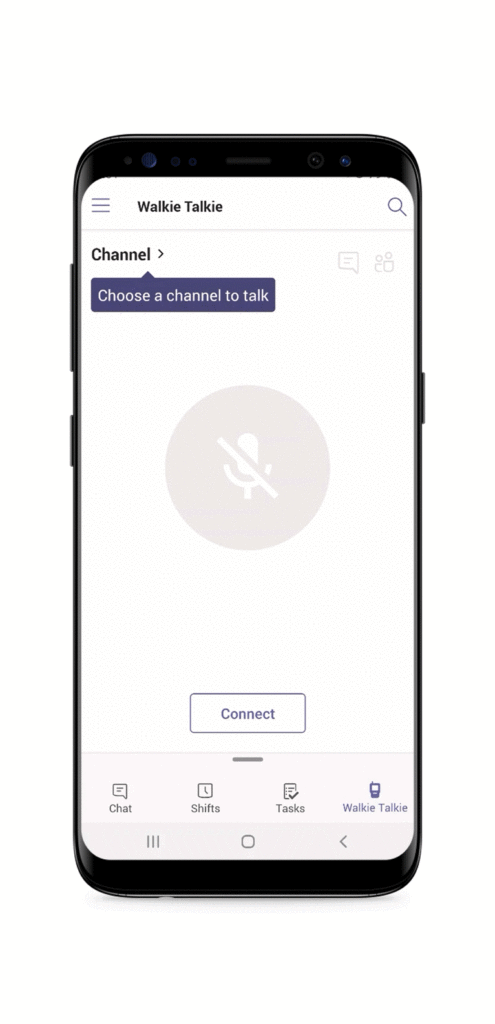
Still to come:
7. Help people learn, reinvent, and grow with the pace of change.
For individuals, teams, and organizations, success in the new world of work requires learning new digital skills, reinventing roles, and finding new ways to grow every day. We want to help our customers provide every employee with the resources they need to incorporate learning right into the flow of their daily work.
This summer, Microsoft launched an initiative to help 25 million people worldwide acquire the digital skills needed in a COVID-19 economy. In the coming months, we will be announcing new learning experiences in Microsoft 365 and Teams to support this initiative, along with other learning opportunities designed for employees across your organization. Check back here for more news, coming soon.
Today at Ignite, we announced seven keys to success to help leaders navigate a new world of work, along with hundreds of new features and capabilities designed to put those principles into action. As we all face new challenges and changes it’s an honor to help our customers reimagine work for the future—and we look forward to bringing you many more exciting announcements in the weeks and months to come.
For in-depth technical-readiness content around Microsoft Ignite news and announcements—including over 100 new Microsoft 365 and Teams videos —visit the new Video Hub.

